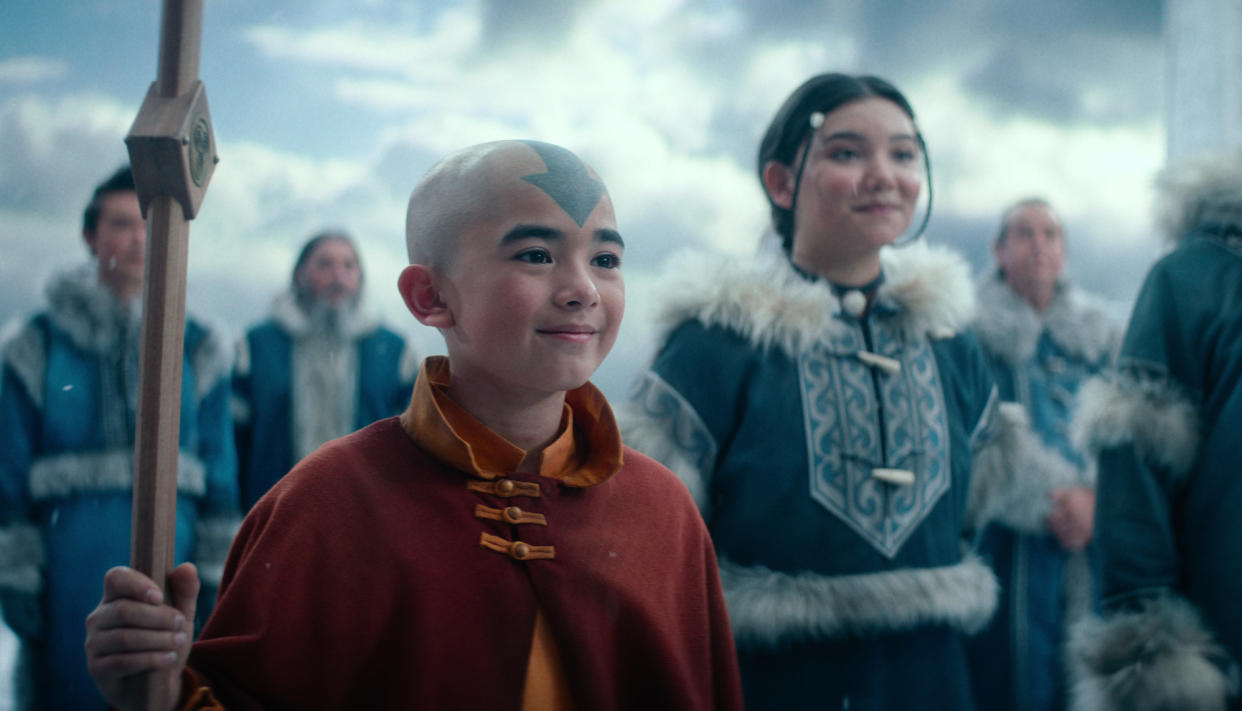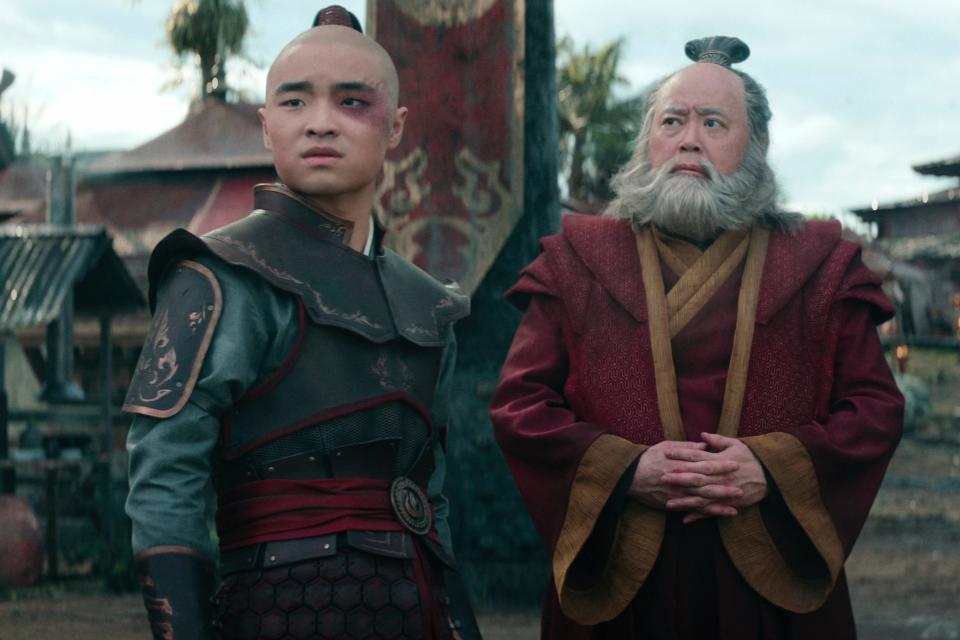‘Avatar: The Last Airbender’ Review: An Inconsistent But Loving Tribute with an Impossible Task

- Oops!Something went wrong.Please try again later.
- Oops!Something went wrong.Please try again later.
- Oops!Something went wrong.Please try again later.
All of Hollywood is looking for ways to reinvent successful stories, but what happens when the original is near-perfect? You have to reinvent the wheel while the prototype is still flourishing in the market, and the inventors watch from afar as their blueprints fall into new hands.
Such is the case with Netflix’s “Avatar: The Last Airbender,” a dramatic reimagining of the beloved Nickelodeon cartoon from Michael Dante DiMartino and Bryan Konietzko. Both creators exited the live-action series in 2020, citing creative differences that have lurked in the shadows while the highly-anticipated end product makes its way to the screen. Under the guidance of showrunner Albert Kim, this is not your Gran-Gran’s “Avatar,” with mixed results.
More from IndieWire
Wes Anderson on Why He Loves Making Shorts: They Set Him Free
'Law & Order' Farewell: There Will Never Be Another Jack McCoy
As the title suggests, the series centers on a figure called the Avatar, one who can master all four elements in a world where water, earth, fire, and air are pillars of culture spirituality, manipulated in the physical world by gifted individuals. In this case, the Avatar also happens to be the last remaining airbender, one whose people were wiped out by the Fire Nation in a century-long war that he missed.
As 12-year-old Aang (waking up from his hundred-year ice nap), Gordon Cormier illustrates more than anything that the hero of this story is truly a child. Though he’s tasked with less of Aang’s fun-loving nature than the original series, that wink of humor is just beneath the surface, and the more dramatic scenes underscore his youthful innocence (basically when he cries you’ll cry). Team Avatar is rounded out by waterbender Katara (Kiawentiio) and her warrior brother Sokka (Ian Ousley), who find Aang in the Southern Water Tribe and then accompany him around the world.
As sweet as the trio is, their union highlights weaknesses in the writing that boil characters down to a singular trait. Aang is noble and heroic — fitting for the character, but repetitive as he restates his values; Katara is hopeful, painfully one-note for a character who contains infinite shades of pain, anger, and power, but isn’t allowed to show any of them until the finale. Only Ousley gets to exhibit a range of characteristics, while burdened with being the show’s only comedic relief. If the series continues, writers should consider giving everyone the Sokka treatment, allowing them to contain and display multitudes while they inevitably grow and change.
But as the iconic monologue goes, everything changed when the Fire Nation attacked — Fire Nation here meaning the jaw-dropping roster of Asian American actors portraying the show’s antagonistic collective, and “attacked” meaning ate and left no crumbs: Dallas Liu, Paul Sun-Hyung Lee, Daniel Dae Kim, Ken Leung, Elizabeth Yu, and more. Liu carries the bulk of it as the banished Prince Zuko, whose fiery emotions and single-minded pursuit of the Avatar fit seamlessly into the show’s tone and show off a deft grasp of the character. Scenes between Zuko and Iroh (Lee, another whose silliness is downplayed in favor of his history as a soldier and father) are electric, providing more heart for the show than even the Avatar’s main story.
And while the nefarious Firelord Ozai isn’t even glimpsed in Book One of the animated series, if you’re going to cast Daniel Dae Kim, you have to use him. Ozai and Princess Azula (Elizabeth Yu) are introduced far earlier both to illustrate the might and calculus of the Fire Nation as well as the exact motivation behind Zuko’s emotional turmoil. Leung is an absolute knockout as the depraved Commander Zhao, blazing with sinister intensity. All of the Fire Nation characters and story are noticeably more developed, especially in contrast with other creative choices that lack the same heft (Zuko’s transfixing arc in “Masks” shows how weak the rest of the episode is in comparison).
As cool as “AtLA” sounds on paper, the logline alone is enough to strike fear into the hearts of Hollywood’s most proficient production heads — but the world of “Avatar” is wondrous to behold, from Farnaz Khaki-Sadigh’s pitch-perfect costuming to Michael Wylie’s production design to the VFX team mastering all four elements. Every single shot poses its own unique challenge, none of them intended to look like our own world, and it’s difficult to fault a few outliers with the whole being what it is.

And still lurks the elephant mandrill in the room: DiMartino and Konietzko’s exit. One has to wonder exactly what happened for them to leave a project so anticipated, a series so beloved — including by the two of them, who launched Avatar Studios in 2021 to expand the show’s universe. After screening all eight episodes of the live-action drama, there is no clear answer, but a likely logical one; that little by little, compromise by compromise, the modifications to their outstanding original story became too much to justify and stick with.
Some of those choices pay off — integrating disparate storylines with a common theme during two episodes in the Earth Kingdom city of Omashu, building out the Fire Nation, nixing a deadline for Aang to master the elements, a character from the final episodes who is not only rewritten but ends up more memorable and endearing than many from the original — while other decisions are head scratchers, their impact diluted if not undermined completely (pretty much everything related to the spirit world).
To that end, a burning (heh) question persists throughout the season: Who is this for? The original series was created for children when this one makes it clear from the outset that it isn’t. The original also happens to be 19 years old, which means that kids who watched it on-air or just after (Chia Anime, anyone?) are adults who can handle a more violent and dire iteration. Elsewhere, constant elucidation suggests that the show wants to be accessible for new viewers, with expository dialogue and overexplained rules, mechanics, and more.
But when all the ice settles, “Avatar: The Last Airbender” is an epic tale and monumental undertaking, one that will stir the ancient feelings in old fans as well as intrigue casual viewers, whether or not they stick around. I gasped when I saw Omashu, marveled at the Kyoshi warriors, cheered like I was at the damn Super Bowl for James Sie reprising his anime role and hitting a beloved line. The season opens strong and gains solid momentum before a weaker back half, but individual performances and breathtaking visuals keep things afloat. This “Avatar” might not be what people know, but the show is on its own heroic journey to realizing its full potential.
Grade: B-
“Avatar: The Last Airbender” is now streaming on Netflix.
Best of IndieWire
Sign up for Indiewire's Newsletter. For the latest news, follow us on Facebook, Twitter, and Instagram.

